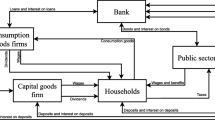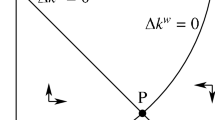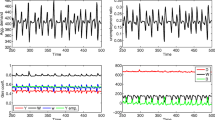Abstract
We model a macroeconomy with stock-flow consistent national accounts built from the local interactions of heterogenous agents (households, firms, bankers, and a government) through product, labor, and money markets in discrete time. We use this model to show that, without any restrictions on the type of interactions agents can make, and with asymmetric information on the part of firms and households in this economy, power-law dynamics with respect to firm size and firm age, income distribution, skill set choice, returns to innovation, and earnings can emerge from multiplicative processes originating in the labor market.




Similar content being viewed by others
Notes
In particular, we use a stock-flow consistent macro framework in the tradition of Taylor [2004] and Godley and Lavoie [2006], the model generates observed empirical regularities such as persistent, endogenously generated dispersions of income in the tradition of Nell [1998] and Angle [2006], and our relates directly to the literature on computational-agent-based macroeconomics, in the vein of Dosi et al. [2006], Gatti et al. [2008], Lorentz and Savona [2008] and Ciarli et al. [2010]. The paper by Ciarli, Lorentz, Savona, and Valente clearly focuses on intra-sectoral dynamics, so it is not very close to our model technically, but has the same spirit. Similarities exist between our paper and Dosi et al. [2006], as well as Lorentz and Savona [2008], with respect to technology. In all papers, innovation and the diffusion of technology shocks are modeled in a similar way. Wright [2005] has a similar model, with no prices and wages drawn from a given distribution, but no banking sector, no government, no education and innovation. Our work is related to agent-based approaches via the assumption of heterogeneous agents, and through the use of simulation to uncover “emergent” phenomena, such as endogenously generated business cycles. Our simple model replicates many of the findings of these agent-based papers, for example, firm size distribution and wealth distributions.
Where a complex system is defined as the simple macroscopic regularity resulting from the interaction of many agents in decentralized exchange [Foley 2003; Angle 2006].
See Singh and Maddala [1976], Ijiri and Simon [1977], Kleiber and Kotz [2003], Cingano and Schivardi [2004], Sinha [2006] and Coad [2008] for summaries of recent work in these diverse fields.
See Dosi et al. [2006], Gatti et al. [2008], Lorentz and Savona [2008] and Ciarli et al. [2010] for survey of such models and related literatures.
There is a risk that new technologies cannot be utilized by the existing workforce, which require retooling, re-skilling, and perhaps new households.
Clearly, when bupper threshold, and blower threshold are set high enough, the government and banks almost never have to borrow from the central bank.
For this set of runs, we set the number of agents as: 500 households, 150 firms, 75 banks. We posit initial amounts of money as: 1,000 for each household and each firm, 10,000 for each bank, 1,000 for the government. The required reserve ratio is rr=0.1, which implies a monetary base of MB=14,01,000.The tax rate is initially set at 10 percent and interest rate for loans is fixed at 1 percent. We parameterize other variables as follows: d=0.1, η=0.7, τ=0.5, γ=1, α1=0.7, α2=0.2, α3=0.1, σH=0.5, σF=0.5, spCollege=100, spB.A.=300, spM.A.=500, spPh.D.=800, θCollege=2, θB.A.=4, θM.A.=6, θPh.D.=8, ponziF=10,000, ponziH=1,000, gthreshold=2,000, bupper threshold=1,000, blower threshold=500. We performed standard robustness checks on our parameters, they did not change the results significantly.
An animation of the money flows between sectors and a dynamic Social Accounting Matrix (http://www.stephenkinsella.net/research) are available from the authors upon request.
See Gonzalez-Estevez et al. [2008] and Hu et al. [2008] for surveys and references.
We thank an anonymous reviewer for the suggestion to discuss the business cycle facet of our model more completely.
Yakovenko [2009] gives the example of a kettle on a gas stove heating slowly, where the kettle has a well defined, but slowly increasing amount.
References
Angle, J . 2006. The Inequality Process as a Wealth Maximzing Process. Physica A, 367: 388–414.
Braun, D . 2001. Assets and Liabilities are the Momentum of Particles and Antiparticles Displayed in Feyman-Graphs. Physica A, 290: 491–500.
Champernowne, David G 1998. Economic Inequality and Income Distribution. Cambridge: Cambridge University Press.
Ciarli, Tommaso, André Lorentz, Maria Savona, and Marco Valente . 2010. The Effect of Consumption and Production Structure on Growth and Distribution. A Micro to Macro Model. Metroeconomica, 61 (1), doi: 10.1111/j.1467–999X.2009.04069.x.
Cingano, F., and F. Schivardi . June 2004. Identifying the Sources of Local Productivity Growth. Journal of the European Economic Association, 2 (4): 720–742.
Clauset, Aaron, Cosma R. Shalizi, and M.E.J. Newman . 2009. Power-law Distributions in Empirical Data. SIAM Review, 51 (4): 661–703.
Coad, Alex . 2008. The Exponential Age Distribution and the Pareto Firm Size Distribution, Jena Economic Research Papers in Economics 2008-072, Friedrich-Schiller-University Jena, Max-Planck-Institute of Economics, Thueringer Universitaets- und Landesbibliothek, September.
Cowell, Frank A . 1998. Measurement of Inequality (Published in Handbook of Income Distribution, A B Atkinson and F Bourguignon (eds), 1998), STICERD — Distributional Analysis Research Programme Papers 36, Suntory and Toyota: International Centres for Economics and Related Disciplines, LSE, July, available at http://ideas.repec.org/p/cep/stidar/36.html.
Dosi, G., G. Fagiolo, and A. Roventini . 2006. An Evolutionary Model of Endogenous Business Cycles. Computational Economics, 27 (1): 3–34.
Foley, Duncan K 1994. A Statistical Equilibrium Theory of Markets. Journal of Economic Theory, 62 (2): 321–345.
Foley, Duncan K . 1999. Notes on the Theoretical Foundations of Political Economy, New School for Social Research, Mimeo.
Foley, Duncan K . 2003. Unholy Trinity: Labor, Capital and Land in the New Economy. Routledge, UK: The Graz Schumpeter Lectures.
Gabaix, X., P. Gopikrishnan, V. Plerou, and H.E. Stanley . 2003. A Theory of Power-law Distributions in Financial Market Fluctuations. Nature, 15 (423(6937)): 267–270.
Gatti, D. Delli, E. Gaffeo, M. Gallegati, G. Giulioni, and A. Palestrini . 2008. Emergence Macroeconomics. New York: New Economic Windows, Springer-Verlag.
Godley, Wynne, and Marc Lavoie . 2006. Monetary Economics An Integrated Approach to Credit, Money, Income, Production and Wealth. Hampshire: Palgrave Macmillan.
Gonzalez-Estevez, J., M.G. Cosenza, R. Lopez-Ruiz, and J.R. Sanchez . 2008. Pareto and Boltzmann-Gibbs Behaviors in a Deterministic Multi-agent System. Physica A, 387 (18): 4637–4642.
Hu, Mao-Bin, Rui Jiang, Yong-Hong Wu, Ruili Wang, and Qing-Song Wu . 2008. Properties of Wealth Distribution in Multi-agent Systems of a Complex Network. Physica A, 387 (23): 5862–5867.
Ijiri, Y., and H.A. Simon . 1977. Skew Distributions and the Sizes of Business Firm. Amsterdam: North-Holland.
Kleiber, C., and S. Kotz . 2003. Statistical Size Distributions in Economics and Actuarial Sciences. Hoboken: Wiley-Interscience.
Lorentz, A., and M. Savona . 2008. Evolutionary Micro-dynamics and Changes in the Economic Structure. Journal of Evolutionary Economics, 18 (3–4): 389–412.
Nell, Edward J . 1998. The General Theory of Transformational Growth: Keynes after Sraffa. Cambridge: Cambridge University Press.
Pareto, Vilfredo . (1896 1965). Ecrits sur la courbe de la repartition de la richesse. Geneve: Librairie Droz.
Singh, S.K., and G.S. Maddala . 1976. A Function for the Size Distribution of Income. Econometrica, 44 (4): 963–970.
Sinha, Sitabhra . 2006. Evidence for Power-law Tail of the Wealth Distribution in India. Physica A, 359: 555.
Spence, Michael . 1973. Job Market Signalling. Quarterly Journal of Economics, 87 (3): 355–374.
Taylor, Lance . 2004. Reconstructing Macroeconomics: Structuralist Critiques of the Mainstream. Boston: Harvard University Press.
Wright, Ian . 2005. The Social Architecture of Capitalism. Physica A, 346 (2): 589–620.
Yakovenko, Victor M . 2009. Econophysics, Statistical Mechanics Approach to, in Encyclopedia of Complexity and System Science, edited by R.A. Meyers. London: Springer.
Author information
Authors and Affiliations
Rights and permissions
About this article
Cite this article
Kinsella, S., Greiff, M. & Nell, E. Income Distribution in a Stock-Flow Consistent Model with Education and Technological Change. Eastern Econ J 37, 134–149 (2011). https://doi.org/10.1057/eej.2010.31
Published:
Issue Date:
DOI: https://doi.org/10.1057/eej.2010.31




